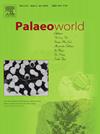Devonian Lingulichnus and in situ lingulids: Taphonomy and paleoenvironments of preservation
IF 1.7
3区 地球科学
Q2 PALEONTOLOGY
引用次数: 0
Abstract
Lingulids are significant infaunal elements of Lower to Middle Devonian in the Paraná Basin, Brazil, with Lingulichnus traces sometimes found in association with in situ lingulids specimens (Lingulida, Brachiopoda). These trace fossils are typically confined to offshore and transitional offshore-to-lower shoreface environments. This study investigates the relationship between Lingulichnus and in situ lingulids, explores their depositional and paleobiological implications. Four taphonomic modes were identified: (i) autochthonous — in situ, isolated lingulids normally associated with Lingulichnus verticalis or L. inclinatus; (ii) allochthonous — lingulids with reworking evidence (e.g., disarticulated or fragmented shells); (iii) autochthonous sub-primary position — in situ lingulids associated to Lingulichnus hamatus; (iv) temporary sub-primary position — in situ lingulids, isolated or associated to L. hamatus or L. verticalis. Except for the former, these taphonomic modes present high paleoecological resolution, and therefore, paleobiological implications. The in situ lingulids, with small size (≤ 1 cm), occur associated with Lingulichnus, suggesting fast burial under high sedimentation rates, and are concentrated in initial transgressive systems tracts in the study area. In this way, isolated in situ lingulids or associated with Lingulichnus can be a good indicator of high sedimentation rates, and demonstrate the preferential preservation of small organism unable to escape from the fast burial.
泥盆纪舌鸟与原位舌鸟:地形学与古保存环境
Lingulids是巴西paran盆地下至中泥盆世重要的动物元素,有时在原位Lingulids标本(Lingulida,腕足目)中发现Lingulichnus的痕迹。这些痕迹化石通常局限于近海和过渡的近海到下岸面环境。本文研究了Lingulichnus与原位舌形动物的关系,探讨了它们的沉积和古生物意义。鉴定出四种分类模式:(i)原生的、分离的、通常与垂直舌虱或斜舌虱相关的舌虱;(ii)异域的-有重新加工证据的舌鱼(例如,脱臼或破碎的壳);(iii)原生次原生位置-与舌鸟相关的原位舌鸟;(iv)临时次原生位置-原位舌状体,分离或与舌状体或垂直舌状体相关。除前者外,其他地层学模式均具有较高的古生态分辨率,因此具有古生物学意义。原位舌状体尺寸较小(≤1 cm),与Lingulichnus伴生,表明在高沉积速率下埋藏速度快,集中于研究区内的初始海侵体系域。因此,分离的原位舌状体或与舌状体相关的舌状体可以作为高沉积速率的良好指标,并证明无法逃离快速埋藏的小生物优先保存。
本文章由计算机程序翻译,如有差异,请以英文原文为准。
求助全文
约1分钟内获得全文
求助全文
来源期刊

Palaeoworld
PALEONTOLOGY-
CiteScore
4.00
自引率
5.90%
发文量
95
期刊介绍:
Palaeoworld is a peer-reviewed quarterly journal dedicated to the study of past life and its environment. We encourage submission of original manuscripts on all aspects of palaeontology and stratigraphy, comparisons of regional and global data in time and space, and results generated by interdisciplinary investigations in related fields. Some issues will be devoted entirely to a special theme whereas others will be composed of contributed articles. Palaeoworld is dedicated to serving a broad spectrum of geoscientists and palaeobiologists as well as serving as a resource for students in fields as diverse as palaeobiology, evolutionary biology, taxonomy and phylogeny, geobiology, historical geology, and palaeoenvironment.
Palaeoworld publishes original articles in the following areas:
•Phylogeny and taxonomic studies of all fossil groups
•Biostratigraphy, chemostratigraphy, chronostratigraphy
•Palaeoecology, palaeoenvironment and global changes throughout Earth history
•Tempo and mode of biological evolution
•Biological events in Earth history (e.g., extinctions, radiations)
•Ecosystem evolution
•Geobiology and molecular palaeobiology
•Palaeontological and stratigraphic methods
•Interdisciplinary studies focusing on fossils and strata
 求助内容:
求助内容: 应助结果提醒方式:
应助结果提醒方式:


